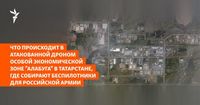On April 23, 2025, the airspace over Kazan, the capital of Tatarstan, was abruptly closed at 07:30, causing a ripple of concern among residents and travelers. This closure extended to the Begishevo Airport in Nizhnekamsk shortly thereafter, with restrictions in place for nearly three hours. During this time, five flights bound for Kazan were redirected to alternate airports, leaving passengers in a state of uncertainty as they awaited further information.
As the morning unfolded, reports emerged from the Alabuga special economic zone, where sounds of explosions began to echo around noon. Eyewitnesses described the chaos as air defense systems were activated in response to an apparent drone attack. According to sources cited by Inkazan, the air defense was indeed operational, but the exact number of drones that had entered Tatarstan remained unclear.
Initial reports on Telegram suggested that two drones had been shot down, but as information circulated, this number rose dramatically, with some witnesses claiming that as many as eight drones had attempted to breach the region's defenses. The head of the Elabuga region, Rustem Nuriev, later confirmed that one drone had been successfully downed over the municipality.
Amidst the commotion, local schools acted swiftly, evacuating children from classrooms and ushering them into basements for safety. The fear was palpable, but fortunately, no injuries or casualties were reported. By 12:31 Moscow time, Rosaviatsiya's representative, Artem Korenyako, announced that the restrictions at Nizhnekamsk Airport had been in effect for over 20 minutes, while similar measures were extended to Kazan by 12:45.
After a tense period, the airspace was reopened at 14:07, with the threat of drone attacks officially lifted by 14:34. However, the day had already seen five additional flights redirected to ensure passenger safety.
The drone threat was not new to Tatarstan, which had experienced similar incidents since January 20, 2025. Prior to that date, the region had been on high alert as Ukrainian drones had launched attacks for a month, causing fires and prompting sirens to sound throughout the area. Despite these earlier threats, residents had begun to associate the recent calm with improved geopolitical relations.
Military expert Dmitry Kornev, associated with the MilitaryRussia project, speculated on the origins of the drones that targeted Tatarstan. He indicated that the attackers might have found vulnerabilities in the region's defenses, which had been touted by local authorities as robust. Kornev suggested that the drones likely flew in from the east, a route that had been used previously.
In the Alabuga special economic zone, where Russian drones are assembled for long-range strikes on Ukrainian cities, the air defense system was put to the test on the same day. The Russian Ministry of Defense confirmed that at least four Ukrainian drones were shot down in the area, with the first explosions reported around 12:30 local time.
Local residents reported seeing drones flying at low altitudes, and footage quickly circulated on social media showing the effective interception of one drone by air defense forces. The Ministry of Defense announced that one drone had been destroyed around 12:20, but it remained unclear how many total drones had been engaged.
Andriy Kovalenko, head of the Center for Counteracting Disinformation of the National Security and Defense Council of Ukraine, commented on the situation, stating that the Alabuga zone, where the Russians produce Shahed drones, had seen increased production capabilities. In 2024 alone, over six thousand strike drones and thousands of decoy drones were produced at this facility, with projections for 2025 indicating a planned output of up to ten thousand Shaheds and around fifteen thousand decoys.
The Alabuga facility, which has been under scrutiny since it was first reported two years ago, has become a focal point for drone assembly. Journalist Anton Rubin, who has extensively covered the operations at Alabuga, noted that the center has rapidly expanded, attracting new students and signing contracts that bind them to the facility for training in drone assembly.
Rubin elaborated on the nature of the contracts, which often obscure the costs of training in fine print. Students are led to believe that their education is free, but if they opt out of continuing with their training, they face steep financial penalties. This has resulted in many students feeling compelled to continue working on military drones, despite the ethical implications.
As the drone threat looms over Tatarstan, local authorities have implemented measures to bolster air defense systems, including the establishment of a situational center called "Clean Sky". This center is tasked with gathering intelligence and coordinating with national defense efforts to monitor aerial threats. However, the recent attacks have raised questions about the effectiveness of these measures and the ongoing risk posed by drone incursions.
In the aftermath of the April 23 incidents, the residents of Tatarstan are left to grapple with the reality of living under the shadow of drone warfare. While the immediate threat may have subsided, the underlying tensions and the potential for future attacks remain a pressing concern.
As Tatarstan continues to navigate this complex landscape, the implications of drone warfare, both locally and geopolitically, will undoubtedly shape the region's future.






